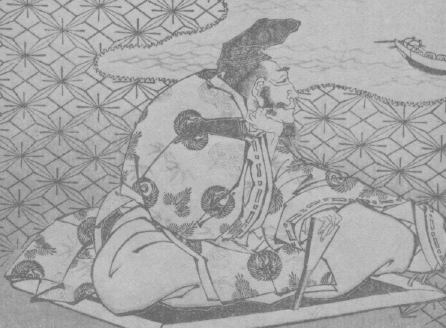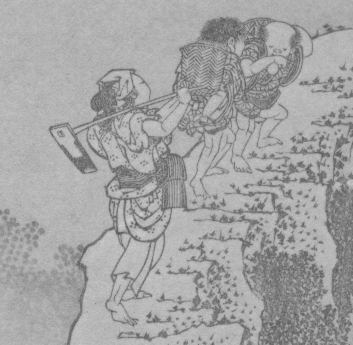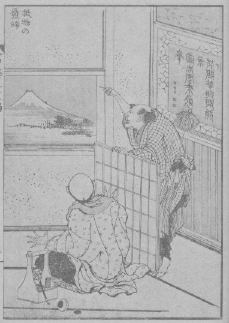Regrets
I was digging through some boxes in my storeroom
one day recently, hunting for a particular book I wanted to read,
when I got a bit sidetracked. I ran across a volume that I bought on
one of my early trips to Japan about fifteen years ago, a trip in
which a lot of my time was spent in used book shops looking for
materials that might be useful in my woodblock printmaking studies.
Pulling it from the box where it had sat 'resting' for many years, I
sat leafing through it, and gradually becoming more and more
absorbed, soon completely forgot about whatever it was that I had
originally planned on reading ...
 I want to tell you something about this little
book, because it has had quite a large impact on my life; in fact if
I hadn't ever seen this book, it's quite possible that I wouldn't be
here today, working on this 'Hyaku-nin Isshu' print series. Some
people are able to point to a particular person who has transformed
the direction of their life, perhaps a teacher from school or
university who inspired them to work in a certain field, but when I
look back at my earlier years, I can't so easily identify any one
person who stimulated my interest in something to the extent that it
changed my life. Like anybody, I have been influenced and helped by
many people, but such influences have, I think, mostly just been
reinforcement of some particular activity in which I was already
working.
I want to tell you something about this little
book, because it has had quite a large impact on my life; in fact if
I hadn't ever seen this book, it's quite possible that I wouldn't be
here today, working on this 'Hyaku-nin Isshu' print series. Some
people are able to point to a particular person who has transformed
the direction of their life, perhaps a teacher from school or
university who inspired them to work in a certain field, but when I
look back at my earlier years, I can't so easily identify any one
person who stimulated my interest in something to the extent that it
changed my life. Like anybody, I have been influenced and helped by
many people, but such influences have, I think, mostly just been
reinforcement of some particular activity in which I was already
working.
Actually I guess that this book would fall into
the same category, as I was already interested in woodblock
printmaking when I ran across it in a Kanda bookshop. It's a good
thing too, for if I hadn't been, I would not have understood enough
about it for it to have made any impact on me. The title is 'Fugaku
Hyakkei', or 'One Hundred Views of Mount Fuji', and it was designed
in the early 19th century by the famous Katsushika Hokusai.
There is no text at all in the book; it consists
of a series of drawings, one hundred in all, each showing a typical
scene or activity of the time. In each of the pictures, totally
dominating some, in others relegated to merely a bump on the horizon,
can be found the familiar cone of Fuji-san. I have no idea who the
customers of such a book would have been when it was originally
published back in the Edo period, or why there would have been demand
for such a book, but it seems to have quite good sales, as the carved
blocks were used to make many editions, and even today the book can
frequently be found in used bookshops specializing in such materials.
I suppose people were attracted by the combination: such an
illustrious theme, treated by such an illustrious designer.

As beautiful as the designs are though, it is not
the content of the book that makes it so important for me - my
interest is in the tangible object itself, this particular assemblage
of delicate paper and black ink. Many beautiful books were published
in the Edo era, and some of them are astonishing creations indeed,
with breathtaking designs, gorgeous colours, and delicate printing,
but this book stands head and shoulders above the rest. It is the
supreme peak of the Japanese woodblock printing tradition. Never
before nor after was a book carved with such superlative technique,
and never was a book printed in more subtle shades of the rich sumi
ink. The entire book is printed only in gradations of sumi; there are
no colours as we usually understand them. But those master printers
could make a single stick of sumi represent a complete spectrum of
colour. To hold a prime copy of this book in one's hands, to turn
gently the pages one after another, drinking in the 'wholeness' of
the combined mastery of the papermaker, the carver, the printer ...
To do this is to understand what Japanese woodblock printing is ...
and to recognize that you hold in your hand one of the most
spectacular objects ever created by human beings.
Katsushika Hokusai knew what he was doing; when he
turned in his drawings to the publisher, ready for them to be carved
onto cherry blocks, he specified who was to be the chief carver of
the book - a man called Egawa Tomekichi. Hokusai chose him because he
knew that for a book of such special designs, only the best would do.
Egawa-san was the best of the best. Among the thousands of
woodcarvers who have worked in this craft from that day to this, none
can compare with him. It is no insult to the men still working today,
as good as some of them are, to say that none can even remotely
approach his skill. He will forever stand apart from all the rest of
us. Every line of every kimono, every leaf of every tree, every curl
of every wave, every feather of every bird ... all dance on the page
in front of our eyes.
The entire world knows the name of Hokusai, how
his drawn or painted figures can seem to be alive on the silk or
paper ... but how many know the name of Egawa Tomekichi? Yet he was
no less an artist than such a man as Hokusai. I suppose that you
think I exaggerate, that I overstate my case, but you who are
thinking this can never have had the experience of holding this book
in your hands. And it is an early copy of the very first edition,
made from the newly carved blocks by top-class printers, that you
must see to understand what I am talking about. Later copies, printed
from the worn-out blocks usually by printers of a lower rank, have
little of this 'magic'.
 It was on that day fifteen years ago, in the
'Hara Shobo' bookshop in Kanda, Tokyo, that I had such an experience.
The proprietor opened the glass case at my request, lifted out the
small, incredibly light volume, and placed it into my hands. It was a
perfectly printed, very early copy of Volume II (the book was issued
as a set of three volumes, appearing some years apart - only the
first two carved by Egawa-san). As much of a beginner at wood carving
as I was then, I understood instantly what I was holding. I gently
turned the pages in a daze; I knew that in a few moments I would have
to return it, but how, how could I burn onto my mind's eye in those
few moments the lessons that were here waiting to be learned? How
could I possibly absorb in such a short time what Egawa-san could
teach me?
It was on that day fifteen years ago, in the
'Hara Shobo' bookshop in Kanda, Tokyo, that I had such an experience.
The proprietor opened the glass case at my request, lifted out the
small, incredibly light volume, and placed it into my hands. It was a
perfectly printed, very early copy of Volume II (the book was issued
as a set of three volumes, appearing some years apart - only the
first two carved by Egawa-san). As much of a beginner at wood carving
as I was then, I understood instantly what I was holding. I gently
turned the pages in a daze; I knew that in a few moments I would have
to return it, but how, how could I burn onto my mind's eye in those
few moments the lessons that were here waiting to be learned? How
could I possibly absorb in such a short time what Egawa-san could
teach me?
The minutes passed, the book was duly returned to
its place in the case, and I passed from the shop. But what has not
passed from my mind, and will never pass from my mind as long as I
live, is the memory of those few minutes of contact with that man -
that man whose body is long dead, but who still lives among us while
copies of these books yet survive. Never, not if I live to be 99
years old, and not if I carve ten hours a day every day until that
time, never will I attain such skill as his. He must have started as
an apprentice at such a young age, must have worked with such a
strict master, must have worked, as they all did back then, seven
days a week with only festival days off, receiving as an apprentice
only the smallest of payments for his work, and probably not much
more even when he became his own master ... He wasn't sidetracked as
I am by working as a printer, by dealing with collectors, with
cooking or cleaning house, by writing essays, by writing newsletters,
by playing with his computer ... He did one thing, and one thing
only, but he did it better than any man had ever done before, or ever
would again.
Sometimes as I sit carving I remember the day I
held that book in my hands, and I remember his carved lines, and I
think that it would be better if I gave up this craft ... What's the
use of continuing when I have no hope of ever attaining that level? I
put down my knife and turn away from the block despondently,
disgusted with the ugliness of the lines I have just carved. But a
few minutes later, I am back. I cannot give up, not while I remember
his lines ... I cannot give up. How many among you can understand all
this? Can there be even a half-dozen people on this earth who know
what I am talking about - who can see what I can see? What's the use
of writing about these things ...
 I put
the title 'Regrets' at the top of this little piece, and I guess I
should explain why. The book I held in the shop that day was for
sale. It was 1981, before the 'bubble' years, and before the world of
Japanese printed books was hit with a massive inflation in values.
The price was 100,000 yen. Just 100,000 yen. That the owner of that
shop was willing to part with this incredible work of art in simple
exchange for ten worthless pieces of coloured paper confounds me as I
think about it now. Was he crazy? And what frustrates me beyond
belief is that I didn't buy it. I wasn't broke, I had that much in
savings set aside, and could have bought it. But I didn't. (In
fairness to myself I have to admit that thinking of mundane things
like food and rent instead of rare books probably was the
common-sense thing to do.) And in the intervening years things have
changed; even in the unlikely event that such a beautiful copy of one
of these books would again become available to me, there is no way
that I could ever hope to possess it. Such things are now the
preserve of wealthy men or museums, men who probably don't even
understand what it is that they own.
I put
the title 'Regrets' at the top of this little piece, and I guess I
should explain why. The book I held in the shop that day was for
sale. It was 1981, before the 'bubble' years, and before the world of
Japanese printed books was hit with a massive inflation in values.
The price was 100,000 yen. Just 100,000 yen. That the owner of that
shop was willing to part with this incredible work of art in simple
exchange for ten worthless pieces of coloured paper confounds me as I
think about it now. Was he crazy? And what frustrates me beyond
belief is that I didn't buy it. I wasn't broke, I had that much in
savings set aside, and could have bought it. But I didn't. (In
fairness to myself I have to admit that thinking of mundane things
like food and rent instead of rare books probably was the
common-sense thing to do.) And in the intervening years things have
changed; even in the unlikely event that such a beautiful copy of one
of these books would again become available to me, there is no way
that I could ever hope to possess it. Such things are now the
preserve of wealthy men or museums, men who probably don't even
understand what it is that they own.
Sometime later, in another bookshop somewhere, I
found a modern 'offset' reproduction edition, printed delicately on
fine paper, stitched together in the old-fashioned way with a needle
and thread, and re-creating, as far as is possible with modern
mechanical techniques, the appearance and feeling of the real volume.
Of course I bought it right away, and it is this book that sits next
to me on the table as I write this. Flipping through the pages, I can
catch some sense of what the original feels like. Hokusai's
illustrations can be clearly seen, and Egawa-san's carved lines are
there in outline, although not in essence. What is missing is the
overall sensation that comes from the combination of masterfully
carved blocks, fine handmade paper, and carefully blended sumi - the
work of many craftsmen being fused into a complete whole by the
pressure of the printer's baren. The book I hold is an imitation, a
shallow substitute.
But I remember the real thing ... oh how I
remember!